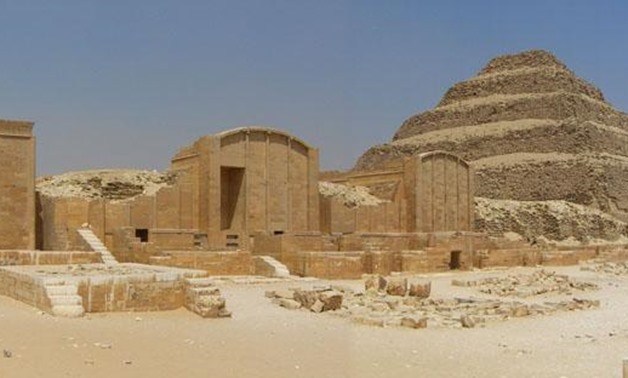
Saqqara Archaeological area and Djoser Pyramid - Ministry of Antiquities official Facebook Page.
CAIRO – 1 July 2018: The Egyptian Museum in Cairo is currently displaying a panel from the Mastaba of Hesy-Ra at Saqqara. Hesy-Ra was a high official holding many titles in the era of King Djoser, including chief of dentists and physicians.
The panel is made of wood with height 115 cms and dates back to the Old Kingdom's Third Dynasty, ca. 2686-2613 BC. The panel is one of six panels from the Mastaba of Hesy-Ra at Saqqara.

Hesy-Ra mastaba depicts magnificent wall paintings and marvellous Old Kingdom wood carvings; such as its outstanding relief panels made from imported Lebanese cedar. The mastaba is the only known example of a painted tomb from the Third Dynasty.The mastaba was discovered by Egyptologists Auguste Mariette and James Edward Quibell in 1861; then its wooden panels and valuable artifacts were brought to the Egyptian Museum in Cairo.

Hesy-re mastaba is of great importance as it shows the developments in the structure and decoration of tombs when compared to other mastabas that were made in earlier eras. The mastaba also reveals new ideas related to ancient Egyptian funerary cult and new beliefs pertaining to the afterlife.
Secretary General of the Supreme Council of Antiquities Mustafa el Waziri visited Saqqara archaeological storehouses on Sunday, February 11, to select some artifacts to exhibit for the first time at the Egyptian Museum in Tahrir and the Grand Egyptian Museum (GEM).
Waziri explained that a number of false doors, offering tables, and wooden painted coffins, as well as other distinguished artifacts were chosen from the Saqqara archaeological storehouses to be exhibited within the museum display.
The Egyptian Ministry of Antiquities is currently working on the maintenance and restoration of Djoser Pyramid located in Saqqara.
The projects sector of the Ministry of Antiquities previously announced that it has almost completed the restoration work of the Djoser Pyramid; the pyramid will inaugurate very soon.
Renowned Egyptian archaeologist Zahi Hawas followed up on the restoration works carried out at the Djoser pyramid in an effort to consolidate the 4,600-year-old monument against time. The Djoser pyramid is the first stone structure in history built by King Djoser, a king from Egypt’s Third Dynasty.
The Cabinet decided to allocate LE 15.3 million ($845,309) to support the restoration and maintenance of the pyramid. The process had stopped in 2011, after the UNESCO report issued in September of the same year stated that the pyramid’s exterior facades suffered from lack of maintenance over the centuries.
Additionally, the removal of the dirt blocks from the pyramid's body led to the creation of many large cavities in several areas, as well as the appearance of many blocks hanging without pillars to support them.
The report also confirmed the existence of some problems in the restoration work. Later, rumours spread that the pyramid was removed from the World Heritage List.
The restoration work on the pyramid began in 2006 and was scheduled for completion in 2009. But fears for the safety of the pyramid increased after the UNESCO’s report, which acknowledged that many irregularities occurred due to the work of the maintenance company; hence, all restoration work has stopped since then.
These irregularities were technical, particularly in the use of limestone to plug the openings that emerged in the pyramid's body, leading to the distortion of the pyramid's external shape. Also, the excessive load on the pyramid became a threat.


Comments
Leave a Comment